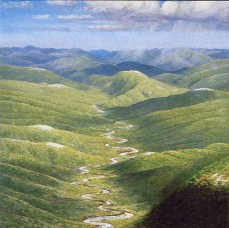 50 million years ago.
The landscape
consisted of rolling hills, broad valleys, and
meandering streams. The Merced River meandered
through a wide trough whose slopes
supported hardwood forests.
50 million years ago.
The landscape
consisted of rolling hills, broad valleys, and
meandering streams. The Merced River meandered
through a wide trough whose slopes
supported hardwood forests.
Evolution of the Yosemite Valley The area that was to become the Sierra Nevada once lay beneath a sea at the west margin of North America. The rock that was formed on this sea floor from deposited silt. mud, and marine organisms was subsequently lifted above sea level and flexed into a mountain range surmounted by a chain of volcanoes much like today's Cascade Range. Granite that formed from molten rock at the roots of these volcanoes eventually would remain as the core of the Sierra Nevada after the overlying sedimentary and volcanic rock gradually weathered and eroded away.
 50 million years ago.
The landscape
consisted of rolling hills, broad valleys, and
meandering streams. The Merced River meandered
through a wide trough whose slopes
supported hardwood forests.
50 million years ago.
The landscape
consisted of rolling hills, broad valleys, and
meandering streams. The Merced River meandered
through a wide trough whose slopes
supported hardwood forests.
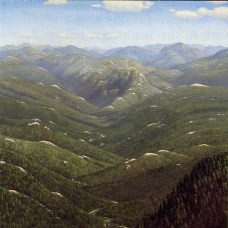 10 million years ago.
A more dissected
landscape ensued as the whole range was
uplifted and tilted westward. This westward tilt
accelerated the Merced River's flow and the
river cut deeper into its valley. The climate
grew cooler and drier. Forests of coniferous
trees, including sequoias, dominated.
10 million years ago.
A more dissected
landscape ensued as the whole range was
uplifted and tilted westward. This westward tilt
accelerated the Merced River's flow and the
river cut deeper into its valley. The climate
grew cooler and drier. Forests of coniferous
trees, including sequoias, dominated.
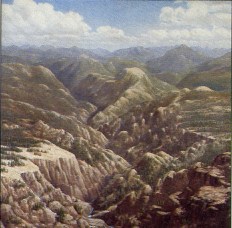 3 million years ago.
A canyon landscape
developed with continued uplift. The raging
Merced cut its canyon as much as 3.000 feet
deep. Its tributary streams, with smaller
drainage basins and volumes of water, cut
more slowly. The Ice Ages approach brought a
colder climate and thinning forests.
3 million years ago.
A canyon landscape
developed with continued uplift. The raging
Merced cut its canyon as much as 3.000 feet
deep. Its tributary streams, with smaller
drainage basins and volumes of water, cut
more slowly. The Ice Ages approach brought a
colder climate and thinning forests.
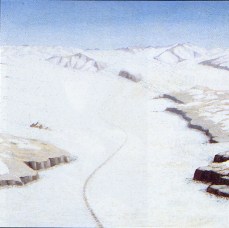 1 million to 250,000 years ago.
At least one
and perhaps more glacial advances filled
Yosemite Valley to its brim. Half Dome
projected 900 feet above the ice, but many
peaks to the north were engulfed. The Valley
was gouged and quarried into a U-shaped
trough with steep walls. Many Merced River
tributaries were now cascades high above the
Valley.
1 million to 250,000 years ago.
At least one
and perhaps more glacial advances filled
Yosemite Valley to its brim. Half Dome
projected 900 feet above the ice, but many
peaks to the north were engulfed. The Valley
was gouged and quarried into a U-shaped
trough with steep walls. Many Merced River
tributaries were now cascades high above the
Valley.
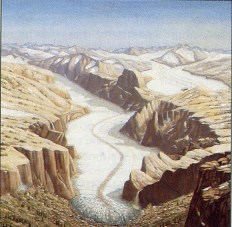 30,000 years ago.
During the Tioga glaciation
Yosemite Glacier. a smaller ice sheet,
advanced into the Valley and terminated near
Bridalveil Fall. As thin as it was, it had little
erosive power to enlarge the Valley further.
30,000 years ago.
During the Tioga glaciation
Yosemite Glacier. a smaller ice sheet,
advanced into the Valley and terminated near
Bridalveil Fall. As thin as it was, it had little
erosive power to enlarge the Valley further.
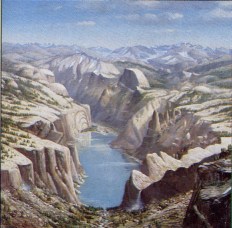 10,000 years ago.
The last Valley glacier hat
melted and its terminal moraine has dammed
the Valley to create a shallow lake, Lake
Yosemite. This was only the last of many Lake
Yosemites that probably followed each glaciation.
The deep excavation created by earlier
glaciers, as much as 2,000 feet into bedrock
beneath the present floor of Yosemite Valley,
was already filled with glacial till and sediments
long before the Tioga glaciation. This last
advance of ice had insufficient erosive power
to reexcavate the Valley to any appreciable
depth. Lake Yosemite eventually filled in with
silt, leaving today's level Valley floor. The
photograph shows Mirror Lake. Today it is filling
in through the same natural processes. Glaciers
did not directly create today's free-leaping
waterfalls, although they helped set the stage.
The falls plunge into alcoves in the Valley walls,
produced by frost-splitting of rock fragments
off the lower parts of the cliffs over which the
waterfalls formerly cascaded. Where the cliffs
are dry most of the time, frost action is not so
effective.
10,000 years ago.
The last Valley glacier hat
melted and its terminal moraine has dammed
the Valley to create a shallow lake, Lake
Yosemite. This was only the last of many Lake
Yosemites that probably followed each glaciation.
The deep excavation created by earlier
glaciers, as much as 2,000 feet into bedrock
beneath the present floor of Yosemite Valley,
was already filled with glacial till and sediments
long before the Tioga glaciation. This last
advance of ice had insufficient erosive power
to reexcavate the Valley to any appreciable
depth. Lake Yosemite eventually filled in with
silt, leaving today's level Valley floor. The
photograph shows Mirror Lake. Today it is filling
in through the same natural processes. Glaciers
did not directly create today's free-leaping
waterfalls, although they helped set the stage.
The falls plunge into alcoves in the Valley walls,
produced by frost-splitting of rock fragments
off the lower parts of the cliffs over which the
waterfalls formerly cascaded. Where the cliffs
are dry most of the time, frost action is not so
effective.


The text and diagrams are from “Evolution of the Valley,” Yosemite: Official National Park Handbook (Washington: Government Printing Office, 1989), pages 66-67. Paintings by H. A. Collins, Sr. (1938)
Copyright © 2004 Dan Anderson. All rights reserved.
Last updated
6 July 2011.
If you have questions or comments, please send a message to Dan Anderson.
http://www.yosemite.ca.us/formation/